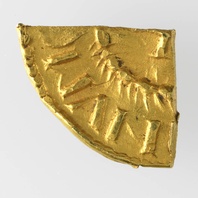
Viking Objects
Imitation Carolingian Gold Solidus (CM.521-1998)
This cut-quarter of an imitation gold solidus is one of 80 known imitations as opposed to 15 official solidi and is a copy of coins issued by Louis the Pious (778-840 CE). It was probably made somewhere in Frisia on the north-west coast of what is now the Netherlands. The importance of this carefully divided quarter-coin is as evidence for the acceptance of solidi on its actual monetary value rather than as mere bullion in the 9th century; if it were hack-gold it would not have been cut so meticulously. The Vikings would have obtained real and imitation Carolingian coins through their raiding and trading activities in the Frankish Empire.
Read More
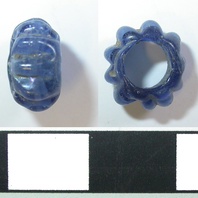
Viking Objects
Blue Glass Bead (2001/59-sf174)
This Viking Age gadrooned or Melon type dark blue glass bead was found in the Magistrates Court excavation in Derby, Derbyshire. Glass beads were a coveted item for making jewellery with some being imported from as far away as the Middle East. They were manufactured by specialised artisans who would heat various coloured glass rods over a furnace and melt the glass onto a metal stick to form different shaped beads.
Read More
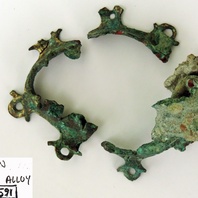
Viking Objects
Gilded Mount (1989-59/7591)
A gilded copper-alloy mount with approximately eight projecting pierced lugs. The mount was found in three pieces and is incomplete. It may originally have been domed, but most of the dome is missing. It has been suggested that it was a shield boss.
Read More
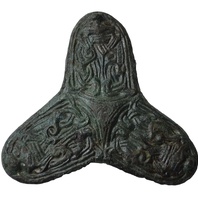
Viking Objects
Trefoil brooch (LCNCC : 2011.99)
A trefoil brooch with Borre/Jellinge-style cast ornament belonging to Peterson’s type 109. The brooch is most probably cast of copper alloy with traces of gilding on its upper surface and white metal plating on the reverse. While of Scandinavian design, many examples found in the East Midlands were probably made in the Danelaw, and may have been copies of Scandinavian styles, instead of being imported from Scandinavia. For more information on Scandinavian jewellery in England check out our blog: Brooches, Pendants and Pins: Scandinavian Dress Accessories in England.
Read More
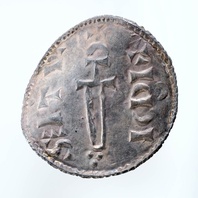
Viking Objects
Sihtric Caoch Silver Penny (CM.863-2002)
A sword and cross type silver penny of Sihtric Caoch (Sihtric Cáech) minted for the Viking kingdom of Northumbria. Sihtric Caoch was the Scandinavian ruler of Dublin from 917-920 CE and subsequently the ruler of Northumbria from 921-927 CE. It is not certain why he left Ireland. The Irish annals state that it was ‘through the grace of God’ and do not elaborate on the politics behind his departure. After the establishment of the Danelaw, some Viking leaders decided to mint their own coins to solidify their legitimacy in the eyes of the local populace. This created a hybrid economy where some members of the Danelaw used bullion and others used coins. This coin was part of a hoard of twelve coins found at Thurcaston between 1992 and 2000. The coins are Anglo-Saxon, Arabic and Viking issues, and show the diverse and wide-ranging contacts between societies at this time. The hoard was probably deposited c.923-925 CE, approximately five years after Leicester had been retaken by Mercia (c.918 CE). They indicate that a bullion economy was still operating in the Danelaw as late as the 920s. This suggests that the reconquest did not manage to institute Anglo-Saxon practices such as a monetary economy immediately.
Read More
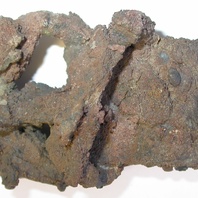
Viking Objects
Iron Buckle (1988/225-9)
An iron buckle found in Mound 6 at Heath Wood, Ingleby, Derbyshire. It is one of two iron buckles found in this burial mound together with a small number of bronze fragments and iron nails. This buckle features a strap slide secured between the backplate and two terminal rivets.
Read More
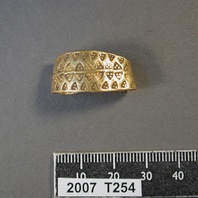
Viking Objects
Gold Stamped Finger Ring (DENO-9A6C17)
A gold finger ring decorated with two rows of interlocking stamped triangles with triple pellets in each. The stamped decoration is typical of Viking jewellery of the late 9th-10th centuries and a punch-decorated gold ring of broadly similar form has been found at Thetford.
Read More
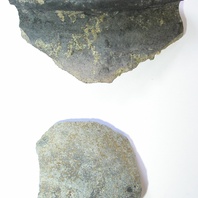
Viking Objects
Early Medieval Pottery (Full Street)
These fragments of early medieval pottery are from Full Street, Derby, a site on the south-eastern corner of the Viking Age town.
Read More
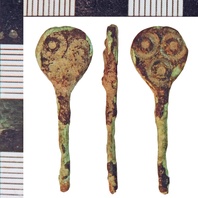
Viking Objects
Ring-and-Dot Pin (NLM-7A2D15)
Copper-alloy cast pin with a flat discoid head, no collar, and stamped decoration on the head, Flixborough type 601. The head bears three large [diameter 4.4mm] ring-and-dot motifs on each of its opposed faces. The tip of the shank is lost. The introduction of flat-headed pins with ring-and-dot decoration, superseding other types, is held by Dave Haldenby to mark the arrival of Viking settlers at Cottam, East Riding of Yorkshire. Suggested date: Early Medieval, 865-925. The finder suggests this to be part of an assemblage amounting to c.5% of material recovered from an extensive site, the rest being removed illicitly without record. Archaeological opinion holds the site to have been of equivalent character to Flixborough, North Lincolnshire, in terms of its material culture. Coins are under-represented in the group.
Read More
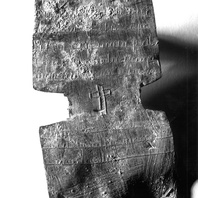
Viking Objects
Inscribed Lead Plaque (LCNCC:1996.64.045)
This lead plaque of uncertain function has a cross incised in its centre and a long Latin text in the Roman alphabet. Like the Saltfleetby spindle whorl, this inscription, too, calls on a divine power, in this case Christ. Between them the two inscriptions represent different responses to literacy and religion in the same time period in neighbouring but probably different communities. (Cumberworth is about 15 miles south of Saltfleetby, in an area with many Scandinavian place-names.) This fragmentary inscription begins with a cross and XPI, the sign for Christ, and after a gap in the text ends with ‘he who by the power of the cross redeemed the world from death, shattered hell or threw open heaven’. The object is dated to the late 10th or 11th century on the basis of the similarity of the writing to contemporary manuscripts.
